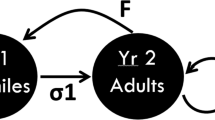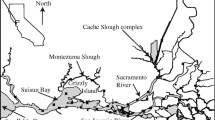Abstract
We introduce a generalized form of the common first-order (exponential) decay model, that has potential utility for describing contaminant declines in environmental applications, particularly when declines are a mixture of many underlying processes. The exponent on contaminant concentration is left as a free parameter allowing the order of the reaction to be determined by the data. The mixed-order model is more flexible than models with the exponent determined a priori, facilitating an improved fit to observed behavior. We demonstrate the utility of this model, and compare it to two other models, by estimating PCB concentration declines in Lake Michigan fishes.
Similar content being viewed by others
References
Bates, D. M. and Watts, D. G.: 1988, Nonlinear Regression Analysis and Its Applications, JohnWiley & Sons: New York.
Berger, J. O. and Berry, D. A.: 1988, Statistical analysis and the illusion of objectivity, American Scientist 76, 159–165.
Devault, D. S., Willford, W. A., Hesselberg, R. J., Nortrupt, D. A., Rundber, E. G. S., Alwan, A. K. and Bautista, C.: 1986, Contaminant trends in lake trout (Salvelinus namaycush) for the Upper Great Lakes, Archives of Environmental Contamination and Toxicology 15, 349–356.
Federal Register: 1993, 58, 20806–20809.
Hebert, C. E., Shutt, J. L. and Norstrom, R. J.: 1997, Dietary changes cause temporal fluctuations in polychlorinated biphenyl levels in herring gull eggs from Lake Ontario, Environmental Science and Technology 31, 1012–1017.
Stow, C. A.: 1995, Great Lakes herring gull egg PCB concentrations indicate approximate steadystate conditions, Environmental Science and Technology 29, 2893–2897.
Stow, C. A., Carpenter, S. R., Eby, L. A., Amrhein, J. F. and Hesselberg, R. J.: 1995, Evidence that PCBs are approaching stable concentrations in Lake Michigan fishes, Ecological Applications 5, 248–260.
Tchobanoglous, G. and Schroeder, E. D.: 1985, Water Quality, Addison-Wesley Publishing Company. Reading, MA. 768 p.
Author information
Authors and Affiliations
Rights and permissions
About this article
Cite this article
Stow*, C.A., Jackson, L.J. & Carpenter, S.R. A Mixed-Order Model to Assess Contaminant Declines. Environ Monit Assess 55, 435–444 (1999). https://doi.org/10.1023/A:1005940627896
Issue Date:
DOI: https://doi.org/10.1023/A:1005940627896




